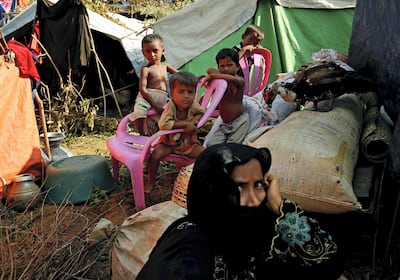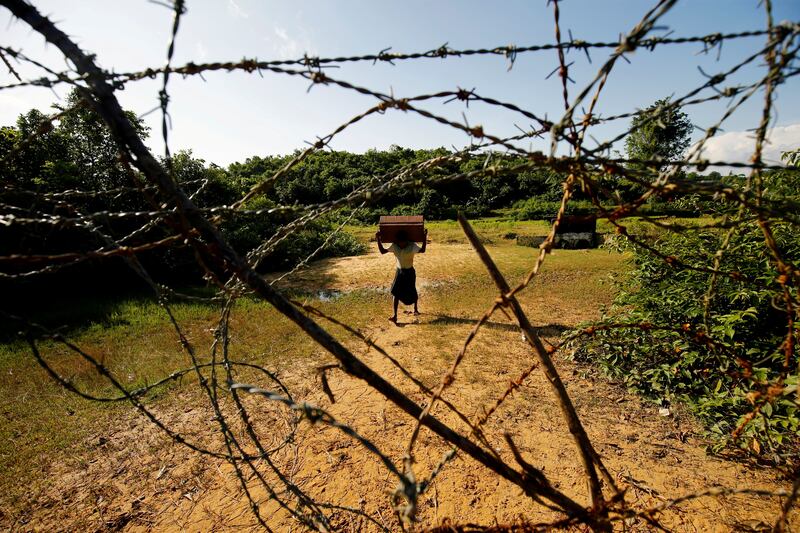Satellite images revealed the large scale burning of Rohinyga villages in Myanmar’s Rakhine State on Tuesday, as UN secretary general Antonio Guterres expressed “deep concern” over reports of civilian killings.
At least ten areas where fires had taken place since Friday, or were still taking place on Monday, were detected in the images, said Human Rights Watch.
The rights group said the blazes were occurring over a much larger swathe of Rakhine than similar fires believed to have been carried out by security force during the widely-condemned operations in the region last October.
The recent fires, which villagers say were started by security forces but the government blames on Rohingya “terrorists”, broke out after the Arakan Rohingya Salvation Army launched deadly attacks on security posts in Rakhine in the early hours of Friday.
The government has since deemed Arsa a terrorist group.
HRW noted further fires may not have been picked up by the satellites because of heavy monsoon clouds.
“This new satellite data should cause concern and prompt action by donors and UN agencies to urge the Burmese government to reveal the extent of ongoing destruction in Rakhine state,” said Phil Robertson, deputy Asia director at HRW. “Shuffling all the blame on insurgents doesn’t spare the Burmese government from its international obligations to stop abuses and investigate alleged violations.”
Details also emerged of other civilians caught up in the fighting in the north of Rakhine where the majority of the population is Muslim.
According to the government, five members of a family from the Daignet minority were killed at the weekend when insurgents attacked their village.

At a meeting with diplomats on Tuesday, security chiefs and government representatives again raised the issue of alleged support for terrorists by international NGOs, suggesting pipes and fertiliser supplied for development could have been used to create improvised explosive devices.
The allegations of complicity by international aid organisations have been widely derided by the international community, and exacerbated anti-foreign sentiment on Myanmar social media.
The information committee of State Counsellor Aung San Suu Kyi posted photographs of destroyed Buddha Statues on its Facebook page on Tuesday, indicating they were damaged by the “terrorists” in Rakhine. Such images will inflame anger across Myanmar where even relatively low scale “insults” to Buddhism result in public outrage and violence.
Indications that Arsa is drawing increasing numbers to its ranks came after AFP reporters in Bangladesh quoted Rohingya refugees there saying many men from camps there had crossed back into Myanmar to join the fight, while others had chosen not leave Rakhine, staying to join the insurgency after sending their families into safety.
"There are hundreds of us hiding in the hills. We took an oath to save Arakan [another name for Rakhine], even if it is with sticks and small knives," one insurgent in Bangladesh near the border told AFP.
Thousands of Rohingya – mainly women and children - have fled to Bangladesh in recent days, amid reports that civilians were being shot by security forces. The latest developments have raised fears of a repeat of last year’s large scale “clearance operations” in the region which the UN said may have amounted to ethnic cleansing. The Myanmar government has refused access to independent investigators.
The attacks by Arsa - which came as an advisory commission led by former UN secretary general Kofi Annan announced its final recommendations on how to ease long-running sectarian tensions in the region – have been widely condemned by the international community. Observers warn the move would inevitably worsen the situation for civilians on the ground.
____________________
Read more:
What hope now for the Rohingya in Myanmar?
Despite alleged arson attacks on Rohingya, Myanmar claims situation 'under control'
Terror and persecution go on for Myanmar's Muslim minority
____________________
But the fighting also prompted calls for the security forces to avoid last year’s brutality and to ensure civilians were protected – calls which increasingly appear to have fallen on deaf ears.
A spokesman for the UN secretary general said he was deeply concerned by reports of killings of civilians. Calling for neighbouring Bangladesh to ensure refugees were allowed in, UN spokesman Stephane Dujarric noted “many of those fleeing are women and children, some of whom are wounded”.
HRW said that while the new satellite images did not allow for the cause of the fires to be identified, in some instances they correlated with reports the rights group had already received from people on the ground saying the buildings had been burned deliberately by troops.
According to the report, “one man who fled to Bangladesh from Taung Pyo Let Yar village, near where Human Rights Watch detected active fires, said he witnessed security forces shooting people as they chased militants, and that homes were set ablaze”.
"Everything has been burned to ashes by now," he reportedly said.





